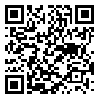BibTeX | RIS | EndNote | Medlars | ProCite | Reference Manager | RefWorks
Send citation to:
URL: http://sjh.umsha.ac.ir/article-1-1073-en.html
Histamine (Hm), formed during decarboxylation of L-histidine by the action of
L-histidine decarboxylase, a pyridoxal phophate dependent enzyme, is one of the main mediator in such allergic diseases as asthma, urticaria and hay fever. Hence Hm assay can be used as a diagnostic tool in these disorders. There are three main methods for Hm assaying: (1) radioenzymatic (2) radioimmunoassay (RIA) and (3) flluorometric. The latter method has the advantage of not using radio active materials. In order to standardize fluorometric assay, the precision and accuracy of the method had to be determined. To do this, standard curve of Hm was drawn and then a single blood sample (taken from IBTS) was tested in 10 tubes for 10 consecutive days. The range of result differences in 100 tests was 5ng/ml and for average of results in 10 days was 1.4ng/ml. Also the coeffecient of variation (C.V.) was 4.01% (precision).
Accuracy of the method was evaluated using recovery percent. This was also done on a single blood sample for 10 consecutive days. The range of recovery percent was 92-98%. Since in fluorometric assay it is preferable to do the tests in triplicate and considering the rather large volume of blood needed for Hm assaying fluorometrically in triplicate (15ml), it was intended to modify the original method so that only 1ml (3ml for triplicate) could be used for the test. To do this a new standard curve of Hm was drawn and precision and accuracy of the modified method was evaluated against the original one, in the same manner as mentioned above. The results of this demonstrated the rather high precision and accuracy of the modified method.
| Rights and permissions | |
 |
This work is licensed under a Creative Commons Attribution-NonCommercial 4.0 International License. |





